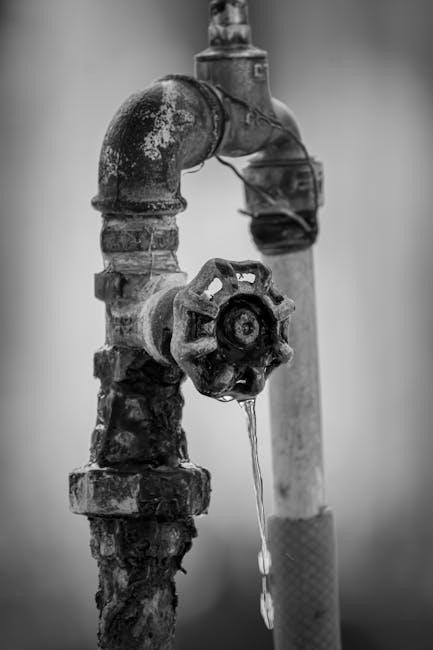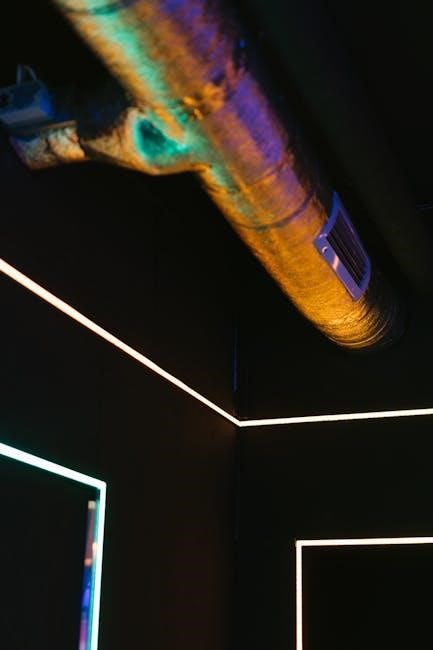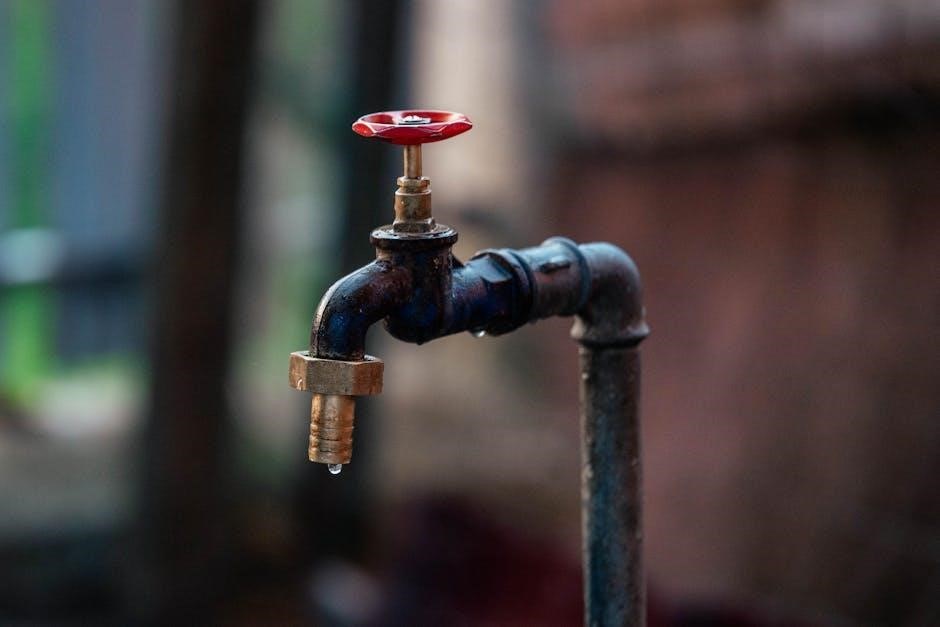PEX piping, or cross-linked polyethylene, is a flexible and durable plumbing material known for its cost-effectiveness and resistance to corrosion. Widely used in residential and commercial systems, it offers superior flexibility compared to traditional copper or steel pipes, making it ideal for radiant heating, water distribution, and repiping projects. Its ability to withstand extreme temperatures and pressures has made it a preferred choice for modern plumbing solutions.
1.1 What is PEX Piping?
PEX piping, short for cross-linked polyethylene, is a flexible plastic piping material widely used in plumbing and heating systems. Developed in the 1960s, it is a cost-effective alternative to copper and galvanized steel, offering durability, resistance to corrosion, and excellent flexibility. PEX pipes are ideal for residential and commercial plumbing, radiant heating, and cooling applications due to their ability to withstand extreme temperatures and pressures. Their cross-linked structure enhances strength and chemical resistance, making them a reliable choice for modern plumbing solutions.
1.2 History and Development of PEX
PEX, or cross-linked polyethylene, was first developed in the 1960s as a durable and flexible alternative to traditional piping materials. Initially used in small-scale applications, it gained popularity in the 1980s for radiant heating systems. Over the years, advancements in manufacturing processes, such as the introduction of new cross-linking technologies, have improved its performance and expanded its use into residential and commercial plumbing. Today, PEX is a leading material in modern plumbing due to its reliability, cost-effectiveness, and adaptability to various applications.
1.3 Advantages of PEX Piping
PEX piping offers numerous advantages, including exceptional flexibility, which simplifies installation and reduces the need for fittings. It is resistant to corrosion, scaling, and freeze damage, ensuring long-term durability. PEX is also quieter than traditional pipes and can withstand a wide range of temperatures, making it ideal for both hot and cold water systems. Its lightweight design and ease of use contribute to lower labor and material costs. Additionally, PEX is environmentally friendly and requires fewer connections, reducing the risk of leaks and potential failures.

Materials and Manufacturing Process
PEX piping is made from cross-linked polyethylene, a highly durable and flexible material. The manufacturing process involves cross-linking polyethylene molecules to enhance resistance to heat, pressure, and chemicals, resulting in a strong, lightweight, and corrosion-resistant pipe ideal for various plumbing applications.
2.1 Cross-Linking Process
The cross-linking process in PEX piping involves creating chemical bonds between polyethylene molecules, enhancing durability and heat resistance. Common methods include peroxide, silane, and electron beam cross-linking. These processes improve the material’s strength, flexibility, and resistance to high temperatures and chemicals, making PEX pipes suitable for diverse applications. The cross-linking degree determines the pipe’s performance, with higher cross-linking levels offering superior properties. This process is critical for ensuring PEX pipes meet rigorous plumbing and heating standards.
2.2 Raw Materials Used
PEX pipes are primarily made from high-density polyethylene (HDPE) resin, which provides excellent mechanical properties. Additives like antioxidants and stabilizers are incorporated to enhance durability and resistance to oxidation. The raw materials are carefully selected to meet stringent quality standards, ensuring the final product is reliable and long-lasting. These components are essential for achieving the desired flexibility, strength, and chemical resistance in PEX piping systems, making them suitable for various plumbing applications.
2.3 Quality Standards and Compliance
PEX pipes must adhere to rigorous quality standards to ensure safety and performance. They are tested for compliance with industry standards like ASTM F2023 and NSF/ANSI 14. These standards verify the pipe’s durability, chemical resistance, and suitability for potable water. Compliance also involves meeting local plumbing codes and regulations. Certified PEX pipes undergo extensive testing, including burst pressure and thermal stability, to ensure they meet or exceed specified requirements. This ensures reliability and consumer trust in PEX piping systems.
Physical Properties of PEX Pipes
PEX pipes are known for their flexibility, durability, and excellent temperature resistance. They offer superior resistance to pressure and stress, making them ideal for various plumbing applications.
3.1 Flexibility and Durability
PEX pipes are highly flexible, allowing them to bend easily without cracking, making installation simpler. Their durability is enhanced by resistance to corrosion, scaling, and chemicals. The cross-linking process improves the polymer structure, enabling PEX to withstand extreme temperatures and pressures. This flexibility and strength reduce the risk of leaks and ensure long-term reliability in various plumbing systems.
3.2 Temperature Resistance
PEX pipes excel in temperature resistance, handling both hot and cold water effectively. They can withstand temperatures from near-freezing to 200°F (93°C), making them suitable for diverse plumbing applications. The cross-linked structure prevents degradation under thermal stress, ensuring consistent performance. This adaptability to varying temperatures enhances their reliability and longevity, reducing the risk of damage or leaks in extreme conditions.
3.3 Pressure Ratings
PEX pipes have robust pressure ratings, typically ranging from 80 to 200 psi, depending on size and application. These ratings ensure reliability in various plumbing systems. Higher temperatures may reduce maximum pressure capacity, but PEX maintains structural integrity across a wide temperature spectrum. Compliance with industry standards like ASTM and NSF guarantees adherence to strict testing protocols, ensuring optimal performance and safety in diverse environments.

Sizes and Dimensions
PEX pipes are available in various sizes, ranging from 1/4″ to 2″, tailored to specific applications. Dimensional tolerances ensure precise fitting and optimal performance.
4.1 Common Sizes Available
PEX pipes are manufactured in a range of sizes to suit various applications. Common sizes include 1/4″, 3/8″, 1/2″, 3/4″, 1″, and 2″ nominal diameters. These sizes are standardized to ensure compatibility with fittings and connectors. The sizing is based on the nominal pipe size (NPS) system, which refers to the nominal diameter. Each size is designed to meet specific flow rate and pressure requirements, making PEX versatile for residential, commercial, and radiant heating systems.
4.2 Dimensional Tolerances
Dimensional tolerances for PEX pipes are tightly controlled to ensure consistency and reliability. The outside diameter (OD) and wall thickness are carefully specified, with minimal allowable deviations. For example, a 1/2″ PEX pipe typically has an OD tolerance of ±0.02 inches and a wall thickness tolerance of ±0.02 inches. These standards ensure proper fitment with fittings and connectors, maintaining system integrity and performance. Compliance with industry standards like ASTM F2023 ensures dimensional accuracy for safe and efficient installations.
4.3 Sizing Guide for Applications
Choosing the right PEX pipe size is crucial for optimal performance. Common sizes range from 1/2″ to 2″ for residential use, while larger diameters suit commercial applications. For radiant heating, smaller diameters like 1/2″ are preferred. Consider factors like water pressure, flow rate, and temperature requirements when selecting pipe size. Manufacturer sizing charts and hydraulic calculations ensure proper sizing, balancing system efficiency and material cost. Always consult local codes and standards for specific sizing recommendations tailored to your application needs.
Fittings and Connections
PEX fittings are designed for durability and ease of installation. They come in push-fit, crimp, and press types, ensuring secure connections. Compatible with various systems.
5.1 Types of PEX Fittings
PEX fittings are categorized into push-fit, crimp, and press types. Push-fit fittings are quick to install and create a secure seal. Crimp fittings use a ring and tool for a reliable connection. Press fittings, like Viega, offer durability and are popular in commercial systems. Each type ensures leak-free connections and resistance to corrosion, making them suitable for both hot and cold water applications.
5.2 Connection Methods
PEX pipes can be connected using Push-Fit, Crimp, or Press methods. Push-Fit fittings are easy to install without tools. Crimp fittings require a tool to secure the ring. Press fittings, like Viega, offer a strong connection. Each method ensures a reliable, watertight seal, suitable for various plumbing needs, ensuring durability and resistance to leaks.
5.3 Compatibility with Other Systems
PEX pipes are compatible with various plumbing systems, including copper, PVC, and CPVC. They can be connected using adapters or transition fittings, ensuring seamless integration. This adaptability makes PEX ideal for retrofitting older systems or combining with different materials in new constructions. Its compatibility reduces installation challenges and allows for versatile system designs, enhancing overall performance and flexibility in plumbing setups.
Approvals and Certifications
PEX pipes gain approvals from NSF, ASTM, and CSA, ensuring safety, durability, and compliance with industry standards for potable water systems, confirming material quality and performance.
6.1 Industry Standards and Certifications
PEX pipes adhere to stringent industry standards, including NSF/ANSI 14 and NSF/ANSI 61, ensuring compliance with safety and performance criteria for potable water systems. ASTM standards like F2023 and PEX 6906 further validate their reliability. Certifications from organizations like the Uniform Plumbing Code (UPC) and International Plumbing Code (IPC) confirm their suitability for residential and commercial plumbing. These standards ensure PEX pipes meet material quality, pressure, and temperature requirements, making them a trusted choice for safe and durable water distribution systems.
6.2 Plenum Ratings and Fire Safety
PEX pipes often carry plenum ratings, indicating their suitability for installation in air-handling spaces like ducts or plenums. These ratings are determined by tests such as UL 910 and ASTM E84, which evaluate smoke generation and flame spread. PEX pipes with plenum ratings meet fire safety standards, reducing hazards in HVAC and ventilation systems. However, specific formulations and certifications are required to achieve these ratings, ensuring compliance with fire safety regulations and building codes.
6.3 Compliance with Local Regulations
Ensuring PEX pipes comply with local regulations is crucial for safe and legal installations. Building codes and plumbing standards vary by region, so PEX systems must meet specific requirements. Material standards, such as NSF International or ASTM certifications, are often mandated. Proper installation practices and compliance with local fire and safety codes are also essential. Always verify regional regulations to ensure PEX piping meets all necessary specifications and standards for the intended application.

Applications of PEX Pipes
PEX pipes are widely used in residential plumbing, commercial systems, radiant heating, and specialty applications due to their flexibility, durability, and resistance to corrosion and freezing.
7.1 Residential Plumbing
PEX pipes are an excellent choice for residential plumbing due to their flexibility, resistance to freezing, and corrosion. They are ideal for water supply lines, offering quiet operation and reduced risk of leaks. Their lightweight design and ease of installation make them a preferred option for homeowners. PEX pipes can withstand varying water temperatures and pressures, ensuring reliability in residential systems. Additionally, they are resistant to scaling and chemical damage, making them a durable solution for modern plumbing needs.
7.2 Commercial Plumbing
PEX pipes are widely used in commercial plumbing for their scalability and durability. They are ideal for large-scale water supply systems, HVAC applications, and industrial processes. PEX pipes offer excellent resistance to corrosion and scaling, making them suitable for high-traffic environments. Their flexibility allows for efficient installation in complex layouts, reducing labor costs. Additionally, PEX pipes are resistant to chemicals and can handle varying water temperatures, making them a reliable choice for commercial plumbing systems. Their lightweight design also simplifies transportation and handling.
7.3 Radiant Heating and Cooling

PEX pipes are highly effective in radiant heating and cooling systems due to their flexibility and ability to handle varying temperatures. They are commonly used for underfloor heating, hydronic systems, and snow melting applications. PEX pipes maintain consistent heat distribution and are resistant to corrosion and scaling. Their quiet operation and lightweight design enhance system efficiency. PEX is ideal for radiant systems because it can withstand high temperatures and ensures reliable performance, making it a preferred choice for modern heating and cooling solutions.
7.4 Specialty Applications
PEX pipes are utilized in various specialty applications, including medical gas systems, marine applications, and geothermal systems. Their chemical resistance makes them ideal for medical systems, while their flexibility suits marine environments. In geothermal applications, PEX pipes are used for underground heat exchange due to their durability and resistance to corrosion. These unique uses highlight PEX’s versatility and adaptability across diverse industries, ensuring reliable performance in specialized settings.

Technical Specifications
PEX pipe specifications include detailed measurements for weight, volume capacity, and pressure loss calculations, ensuring precise performance metrics for various applications and installations.
8.1 Weight per 100 Feet
PEX pipes vary in weight per 100 feet depending on size and type. Common sizes range from 1/2″ to 2″, with weights typically between 10 to 50 pounds per 100 feet. Larger diameters naturally weigh more due to increased material. This measurement is crucial for shipping, handling, and installation planning. Always refer to the manufacturer’s specifications for exact weights, as variations exist based on pressure ratings and specific applications.
8.2 Volume Capacity
The volume capacity of PEX pipes depends on their inner diameter and wall thickness. Common sizes range from 1/2″ to 2″, with capacities typically between 0.25 to 4.0 gallons per minute (GPM) at 60 psi. Larger diameters increase flow rates, while smaller diameters reduce flow. Exact capacities vary by manufacturer and specific pipe grade, so always consult the manufacturer’s specifications for precise data tailored to your application needs. This ensures proper system design and performance.
8.3 Pressure Loss Calculations
Pressure loss in PEX pipes is calculated using the Hazen-Williams equation, considering flow rate, pipe diameter, and length. Factors like fittings, valves, and pipe bends also contribute to friction losses. For PEX, pressure loss typically ranges between 5-15 psi per 100 feet, depending on the application. Accurate calculations ensure proper system sizing, maintaining optimal flow rates and pressure. Always refer to manufacturer-specific data for precise values, as they may vary slightly by pipe grade and size.

Installation Guidelines
Proper tools and preparation ensure successful PEX pipe installation. Avoid kinking, secure pipes every 6-8 feet, and follow safety guidelines for a safe setup and long durability.
9.1 Bending and Flexibility Limits
PEX pipes are highly flexible but require careful handling to prevent damage. The minimum bend radius varies by size, typically 4-8 times the pipe’s diameter. Avoid sharp bends or kinking, as this can weaken the material. Use bending tools for precise curves and ensure the pipe is not stretched or compressed beyond its limits. Proper bending techniques ensure optimal performance, durability, and prevent leaks. Always follow manufacturer guidelines for specific bending recommendations to maintain system integrity and long-term reliability.
9.2 Support and Hanger Spacing
PEX pipes require proper support to prevent sagging and ensure even weight distribution. Hangers or supports should be installed at maximum intervals of 4 to 6 feet, depending on pipe size and operating conditions. For horizontal runs, supports are typically spaced every 4 feet for 1/2″ to 1″ pipes and every 6 feet for larger diameters. Vertical runs may require closer spacing. Ensure hangers are securely fastened and avoid over-tightening, which can damage the pipe. Proper support prevents damage and maintains system performance.
9.3 Tools and Equipment Needed
Installing PEX piping requires specific tools for precise connections. Essential tools include a PEX tubing cutter for clean cuts, a PEX ring removal tool for removing old connections, and a PEX expander tool for creating secure fittings. A go/no-go gauge ensures proper sleeve insertion, while a compression tool is used for crimp rings. Additionally, a pencil marker and measuring tape aid in marking and cutting pipes accurately. Proper tools ensure leak-free connections and long system durability, making them indispensable for any PEX installation project.

Maintenance and Troubleshooting
Regular inspections for leaks, corrosion, and fitting integrity ensure system longevity. Addressing issues like blockages or noise promptly prevents major damage, maintaining optimal performance and safety.
10.1 Common Issues and Solutions
Common issues with PEX pipes include leaks at fittings, kinking, or blockages. Solutions involve checking connections for tightness, using bending tools to prevent kinks, and flushing the system to remove debris. Regular inspections and prompt repairs help maintain system efficiency and prevent costly damage. Proper installation and adherence to specifications minimize potential problems, ensuring long-term reliability and performance of PEX piping systems in various applications.
10.2 Inspection and Testing Methods
Inspection of PEX pipes involves visual checks for damage, kinks, or improper connections. Pressure testing is conducted to ensure system integrity and detect leaks. Non-destructive testing methods, such as ultrasonic testing, can assess pipe condition without causing damage. Regular inspections help identify potential issues early, ensuring compliance with safety and performance standards. Proper testing protocols are outlined in industry guidelines, guaranteeing reliable and long-lasting PEX piping systems across various applications.
10.3 Repair Techniques
PEX pipe repairs typically involve removing damaged sections and replacing them with couplers or connectors. For minor leaks, compression fittings or push-fit connectors can be used. In cases of excessive damage, the entire section may need replacement. Proper tools, such as tubing cutters and go/no-go gauges, ensure precise cuts and secure connections. Following manufacturer guidelines is crucial to maintain pipe integrity and prevent future issues. Regular maintenance and timely repairs help extend the lifespan of PEX piping systems.

Environmental Impact
PEX pipes are lead-free, recyclable, and reduce waste. Their durability minimizes leaks, conserving water. Lower chemical usage during manufacturing supports eco-friendly practices, making them a sustainable choice.
11.1 Sustainability of PEX
PEX pipes are highly sustainable due to their long lifespan, reducing replacement needs. They are lead-free, minimizing environmental contamination. The manufacturing process uses less energy than traditional materials like copper. PEX is recyclable, reducing waste, and its flexibility minimizes material usage during installation. These factors contribute to a lower environmental footprint, making PEX a greener alternative for modern plumbing systems.
11.2 Recyclability and Disposal
PEX pipes are recyclable, as they are made from high-density polyethylene (HDPE), which can be reused in various applications. Proper disposal involves recycling programs that process HDPE materials. If recycling isn’t available, PEX pipes should be disposed of in landfills, adhering to local regulations. Improper disposal can harm the environment, so responsible handling is crucial to minimize ecological impact.
11.3 Eco-Friendly Benefits
PEX pipes offer several eco-friendly benefits. Their durability reduces the need for frequent replacements, minimizing resource consumption. The flexibility of PEX allows for longer installations with fewer fittings, decreasing potential leaks and conserving water. Resistance to scaling and corrosion enhances energy efficiency by preventing reduced water flow that would otherwise increase energy use. PEX is ideal for radiant heating systems, which can be more efficient than traditional systems, lowering energy consumption and emissions. Additionally, the lightweight nature of PEX reduces transportation emissions, and its chemical resistance protects water quality. These factors contribute to a more sustainable and environmentally friendly plumbing solution.

Future Trends in PEX Technology
Future trends in PEX technology include advancements in manufacturing processes, development of eco-friendly materials, and integration with smart systems for improved performance and sustainability.
12.1 Innovations in Manufacturing
Manufacturing innovations in PEX piping include advancements in cross-linking technologies, such as improved UV and silane methods, enhancing durability and flexibility. Automation and precision engineering are optimizing production, reducing waste, and ensuring consistent quality. Research into biobased polymers is driving sustainability, while 3D printing is emerging for custom fittings. These innovations aim to improve performance, reduce environmental impact, and expand PEX applications in modern plumbing systems.
12.2 Emerging Applications
PEX piping is expanding into emerging applications like greywater systems, rainwater harvesting, and smart building technologies. Its flexibility and corrosion resistance make it ideal for hydronic heating and cooling in modern architecture. Additionally, PEX is being adopted in geothermal systems and niche markets such as recreational vehicles and marine applications. Its lightweight and scaling-resistant properties are driving its use in medical gas systems and renewable energy projects, further diversifying its role in sustainable infrastructure.
12.3 Industry Growth Projections
The PEX piping market is projected to grow significantly due to increasing demand for efficient plumbing solutions. Rising construction activities, especially in residential and commercial sectors, drive this expansion. Urbanization and infrastructure development in emerging economies further fuel growth. Additionally, the adoption of PEX in renewable energy systems and water conservation projects supports market expansion. Industry analysts predict a steady growth rate, with PEX becoming a preferred choice for modern plumbing needs due to its durability and versatility.